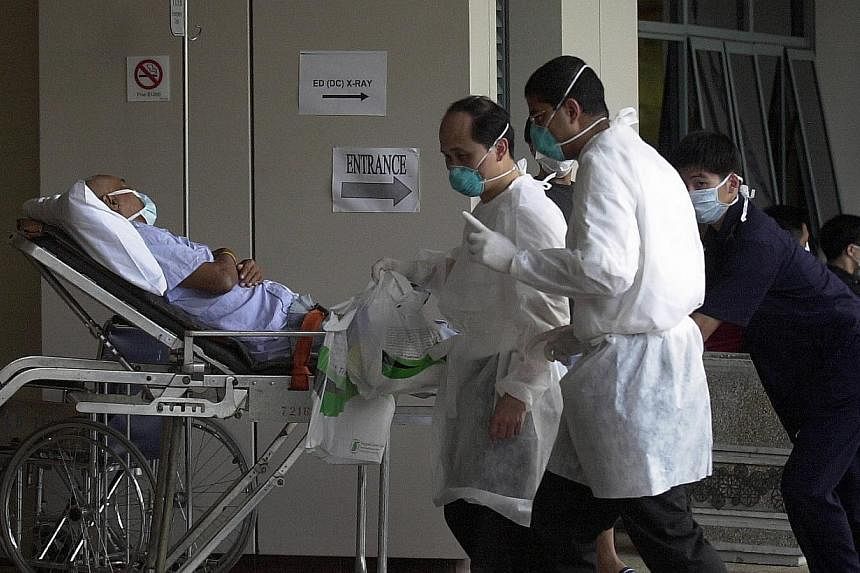Will Mers one day be as familiar to Singapore as Sars?
With the threat of the Middle East Respiratory Syndrome entering Singapore, many Singaporeans' thoughts have been turning to Sars.
Sars crept into Singapore like a thief in the night, on March 1, 2003 when the first patient was admitted. No one knew its name then. Just a collection of symptoms common to respiratory diseases, except the lungs were cloudy and showed patches.
On March 15, the World Health Organisation called it Sars. It sounds like the Chinese word for kill.
Sars raged across Singapore. Tan Tock Seng Hospital (TTSH). Then Singapore General Hospital. Then into the community, at Pasir Panjang Whole Sale Centre, and National University of Singapore Hospital. People who came into contact with patients were quarantined - at home, in chalets, in hotels. Even a Housing Board block was set aside, but wasn't needed. Children learnt to wash hands in school. Fear gripped a nation.
And then the tide turned.
Nurses shunned by neighbours were lauded as heroes. The Courage Fund was started. People got tired of staying home and went out, to concerts, to shops. The economy picked up. Sars was contained. Ministers drank Sarsi.
On May 30, WHO took Singapore off the Sars list.
Sars raged for exactly two months. It took 33 lives, infected 238 and affected thousands.
Sars left a legacy. For those who lost loved ones, grief and pain. For patients, lives turned topsy turvy, the search for meaning. For health care workers, Sars left a legacy of courage and service. People went in expecting to die. Young nurses volunteered to serve in Sars wards.
For the rest of us, Sars lives on in the form of protocols and rituals we have become used to. Like washing hands, having hand sanitisers everywhere, even in one's own handbag. Temperature screening at hospitals. Seeing people in gowns and masks outside hospitals.
What did we learn, what can we learn from Sars?
1. Disease is no respecter of persons.
This is so obvious, but it bears repeating in today's anti-foreigner mood among some. Those who died, include a 28 year old woman from India, who left behind a bereft husband. A male nurse from the Philippines, working in the Orange Valley nursing home.
When you live together on one tiny island, and disease strikes, there is no home-ground advantage.
2. We're in it together
Foreigners chipped in alongside Singaporeans. We know many health care workers were from the Philippines, or China, and elsewhere. That thermal scanner we've gotten used to seeing in airports. Singapore engineers worked on it. But one of the first seed ideas came from an American engineer working in Singapore, Chuck Hampton. A woman who was a Permanent Resident organised a website with information and links on Sars.
In Moon Crescent Prison, prison inmates were doing the laundry for affected wards in hospitals.
In schools students raised funds for the Courage Fund. Someone dropped off 60 crates of Fuji apples for Emergency Department staff at TTSH. Another gave 1,000 stalks of gerberas. Both remained anonymous.
Grassroots volunteers helped buy food for those on Home Quarantine Orders.
3. The state matters.
In a crisis, no matter how many pairs of helping hands you have, the fact is, you need a head, a leader. To be sure, some faulted the government for not being fast enough, and for setting up a central coordination team a bit too late. But when they came on board, they were effective.
What worked?
Perhaps central coordination across ministries, at Cabinet and in the civil service. The late-night daily press conference, late at night, updating people and dispelling rumours.
What if Sars, or Mers, happened today? Would we come together, knowing we're in it together? Or would we be critical, throwing stones at people doing their best?
It is 11 years, but Sars has become part of the national consciousness.
My own thoughts turned to Sars because I gave a talk on Friday on this subject, with colleagues Salma Khalik and Stephanie Yeow, This was part of a photo exhibition WE: Defining Stories, organised by The Straits Times and the National Museum.
I had written a book on how Singapore dealt with Sars, interviewing patients, doctors, civil servants. A Defining Moment: How Singapore beat Sars was published in 2004 by the Institute of Policy Studies.
Excerpts from the book are here:

